textshow (1)
By:
March 26, 2018
Being the first session in a new quarterly series of passionate conversations from the cafeteria of pop-culture: textshow throws a variety of artistic observers into the arena of social media, to discuss movies, comics, TV and other artifacts of the collective media consciousness just waiting for some free association. Conducted in real-time, these threads are followed where they feel like, with the tangential revelations and composed spontaneity only this new media makes possible. The first fruits of this method are found below!

In myth, in dreams, in mass-market fantasies, there’s no world we never made — but we can’t ever count on living in all of them. Aspirational would-be edens, cautionary dystopias, glass globes of time and roads actually taken sustain, divert, frighten and inspire us — and this innate virtual existence is opening out in more directions, and has room for everyone. Wakanda, Themyscira, Gotham City, Gilead — we’re comforting ourselves, scaring ourselves with more fully-realized virtual worlds as our everyday existence seems harder to make sense of. In the process, we may even be waking ourselves up.
I set out to survey these landscapes with experimental theatre creator Christopher-Rashee Stevenson, illustrator Diana Leto and writer/activist Joe Corallo [see bios below], three artists whose work often confronts racial, gender, and sexuality fault lines and common ground.
HILOBROW: Hey, everyone. Welcome to the first session of textshow. I want to make it as comfortable as I can, so:

HILOBROW: OK, NOW it’s a Q&A…
CORALLO: Excellent. I’m making some Death Wish Coffee as we speak!
HILOBROW: Our first product-placement!
LETO:
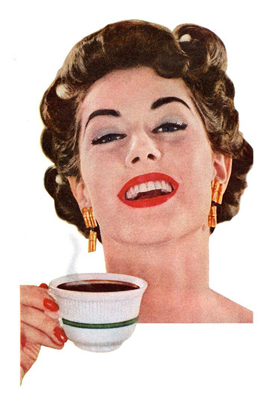
HILOBROW: I know full well what’s in that coffee, Diana…
LETO: Ha!
STEVENSON:
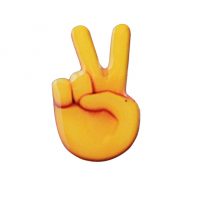
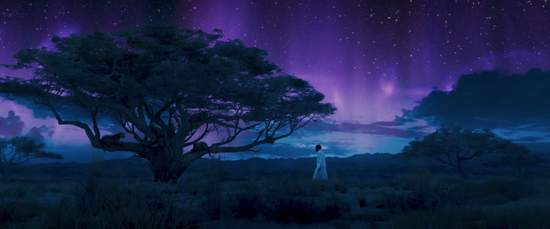
HILOBROW: So. Some of my questions may drag on longer than William F. Buckley approaching a black hole, but we can start off with a shorter one: Is Black Panther a superhero movie? (Its appeal seems to have exceeded the comic audience, and its alternate-world proposition is based as much in sociology as science-fiction…)
STEVENSON: It’s as much an afro-futurist utopian dream as it is superhero movie. Shakespearean epic. Coogler’s going for it all.
HILOBROW: It’s the first high-profile narrative of Africa that has Africans (at least Diasporic) as the creative driving force… what do you see has changed?
STEVENSON: Well just in the fact that it DARES present a vision of Africa (or a magical-realist pocket of Africa) never tainted by imperialism, colonialism, and goes from there. Blacks aren’t forced to be in RELATION to whites. Though Andy Serkis [as Klaw] is wonderful and chewing the scenery for everything it’s worth.
CORALLO: Haha Andy Serkis is certainly great!
STEVENSON: It dares look into the pains and conflicts we have unhealed within our own community, without the excuse of “the white man” made me do it.
CORALLO: [As Agent Ross] Martin Freeman to me towards the end had sort of the same role as Falcon in Winter Soldier where he was given something important but not too important. It was nice seeing that flipped.
LETO: I agree with Christopher but going back to “Is Black Panther a superhero movie?” — Personally, I would say that Black Panther is a superhero movie but for me it’s more of a feminist movie. It’s the most empowering, intelligent, and strong depiction of women I’ve seen on the big screen.
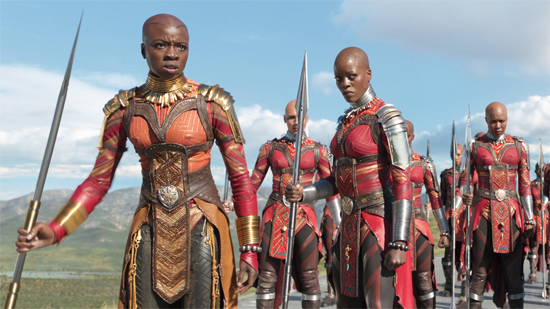
CORALLO: It’s an incredibly feminist movie.
STEVENSON: Amen! We basically are given the female counterpoint to Tony Stark in Shuri — brilliant, a princess, a scientist. Who would no doubt kick Iron Man’s ass.
HILOBROW: There’s already been talk of Shuri becoming the MCU’s Ironheart [the comicbook successor to Stark, Riri Williams], which I can’t wait for if it’s true.
The whites we see in Black Panther are recognizable to any white viewer who, in the words of Howard Beale, has “run out of bullshit”… and you’re right @Christopher-Rashee Stevenson, the narrative is unsparing about both colonial arrogance and internal dysfunction. Why do you think people are ready to look at this — and indeed seek it?
STEVENSON: I think that starts unfortunately with numbers. They’ve seen that given the right ingredients Black stories and representation DO WORK on a mainstream monetary scale. And everyone else seems to be following suit — Moonlight, Atlanta, Queen Sugar, all of Shonda Rhimes’ work. They see that with the right stories and the right people behind it, they work.
CORALLO: For me, people have been ready to see this for far too long, and were so starved for it that it propelled this movie to major success at a time of year where movies don’t tend to perform this well ever.
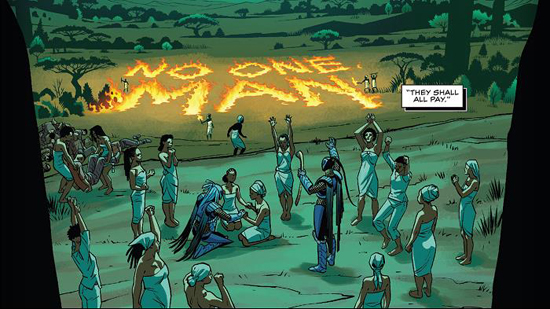
LETO: I think the narrative that speaks about colonial arrogance and internal dysfunction is relevant to today’s political atmosphere. We are familiar with the struggle for leadership that has our best interest in mind.
HILOBROW: That could be, @Diana Leto — certainly the Ta-Nehisi Coates Panther comic is one of the most riveting “civic thrillers” I can remember, and its popularity is probably because of a hunger for making sense of social dynamics no one can any longer ignore…
CORALLO: It definitely speaks to politics of the moment, and unfortunately whether it was intended or not it’s a reflection on the balance between isolationism and interference that our political power players are currently weighing openly and to the detriment of world order.
HILOBROW: Yeah @Joe Corallo, it’s fascinating that this parable of an ideal Africa is in some ways built to remind viewers of what America is supposed to be about… fair game I guess, since George Will has pointed out how the Make “America” Great movement is stuffed with rightwing mystic nationalists on the European model.
Before Black Panther, I had noted that the Luke Cage Netflix series was the most matriarchal of Marvel’s cinematic works (even more so than Jessica Jones) — why do Black narratives open up to this more?
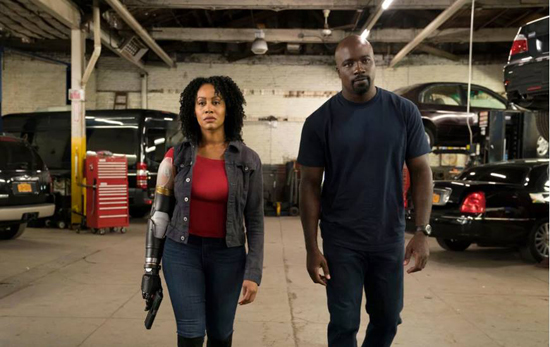
STEVENSON: Most of us were raised by women; single households, strong women. Women who understood equal parts nature and nurture.
HILOBROW: True, @Christopher-Rashee Stevenson — and you may have just helped me understand something about my own background. I grew up with a Jewish mom, a matrilineal culture with a scriptural (and political) tradition of kickass women… I’ve always wondered why, whenever a comic with a female star would come out in my childhood (The Cat, Night Nurse, etc.) I’d devour it, but I never perceived how few there were and why they’d get cancelled so quick. Maybe because in my heritage women were strong and self-possessed in themselves, but still subordinated socially.
LETO: That’s a great question. Perhaps because with JJ she is a powerful character but primarily a loner. The women in Luke Cage are both powerful and supportive, having a love of family and community with a no-BS approach.
HILOBROW: JJ is a product of the indifferent, drifty white family. I know “setting-is-character” is a well-worn critic’s cliché at this point, but in the two JJ series, it could be speculated that the suburbs are a villain.
LETO: LOL! Enter Killgrave.
STEVENSON:
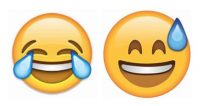
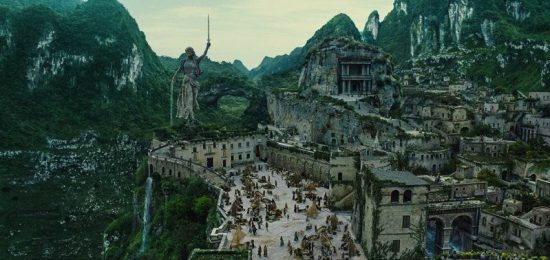
CORALLO: If you all don’t mind, I don’t mean to speak out of turn or ask the questions really, but when it comes to Jessica Jones and Luke Cage, or Wonder Woman and Black Panther, are there issues of one being more representative of feminist views or is it more that they are addressing different aspects of feminism, even if one may be encompassing more than the other?
STEVENSON: Wow, that’s a question.
HILOBROW: Ask away! And, I think the latter — different facets. Jessica Jones unfolds in a frame of reference that’s utterly revolutionary for mainstream American culture… as does Luke Cage. There’s so much in each show that I was amazed to see they “knew,” since I know it’s what female and African-American friends of mine know…
STEVENSON: Black Panther’s set up requires more of a leap — or suspension of what we’ve been taught for who knows how long. Not just about Africa but technology, its possibilities and where that’s headed.
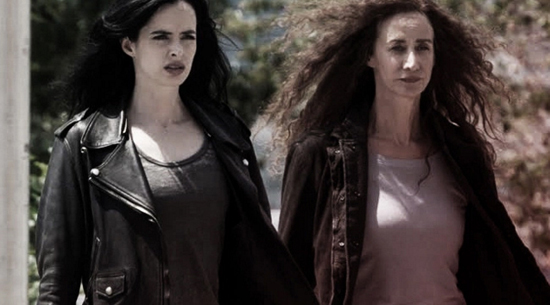
LETO: In Luke Cage, although this aspect is in most of the shows we are talking about, there is a sense of all the women having different points of view (and therefore different points of feminism) but when it comes down to a serious conflict or situation they are facing, they understand they are stronger together. This is especially apparent in Luke Cage with all the strong Black women.
HILOBROW: There’s just a more unbroken community of women in Wonder Woman than in JJ, and of Black peoples in Black Panther than in Luke Cage (part of that is the utopian aspect of which @Christopher-Rashee Stevenson speaks).
STEVENSON: Due to an in-flooding of good (inclusive) writers’ room or…?
HILOBROW: That has to be part of it, @Christopher-Rashee Stevenson …as I said in reviewing Luke Cage, “I won’t say it had to take a mostly-Black staff to get this right, but evidently it did.”
STEVENSON: Of course, right down to the music — also must shout out Disney for allowing Coogler to let Kendrick Lamar curate the soundtrack.
CORALLO: Black Panther was hands-down the best soundtrack of these Marvel movies. And I’m suspect of those who disagree lol.
HILOBROW: Omg that is the most astute Pan-African soundtrack I’ve ever heard — Baaba Maal all over the place, Kendrick working in the diasporic branches so well…
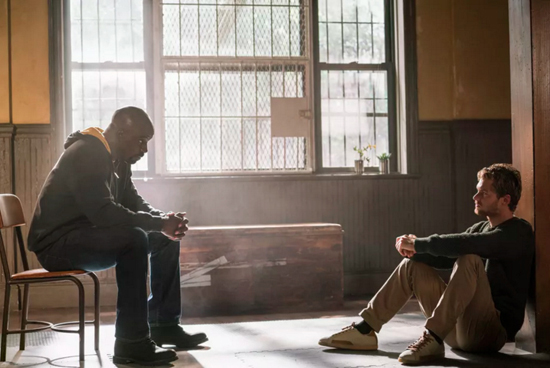
CORALLO: At least Marvel did Iron Fist right after, to show us they are capable of messing up cultures still. I was getting worried there.
HILOBROW: I’m fascinated to contemplate if Finn Jones really understands what he’s gotten himself into — he did beg fans to wait ’til they’d seen “what we do with it,” and what they did with it was make him a whiny entitled schmuck who’s the perfect target for Luke’s spot-on anti-gentrification rants in The Defenders, and who is told at the end of his own series by Rosario that he’s a sociopath, and we’re clearly meant to agree…
STEVENSON: Another rabbit-hole: Killmonger vs. Heath Ledger’s Joker. This has been a comparison. I see it. But I think it’s impossible to compare them.
HILOBROW: The bravery of Black Panther is that every character has a valid point (if not always a valid reaction)… we totally understand what has formed Killmonger, whereas Joker is tabula rasa… an embodiment of fears, while Killmonger is a humanization of trauma.
CORALLO: I think Killmonger is more interesting. Heath’s Joker veers into the chaos for the sake of it, and that can get lost in the shuffle and quickly turn into a less interesting situation. Fifteen-year-old white-boy me that thought Fight Club was interesting would be all about Heath lol.
STEVENSON: LMAO
HILOBROW: Well, @Joe Corallo, they’re a litmus-test for who the characters truly are…
STEVENSON: @Adam Yes! Yes! The best villains are our mirrors.
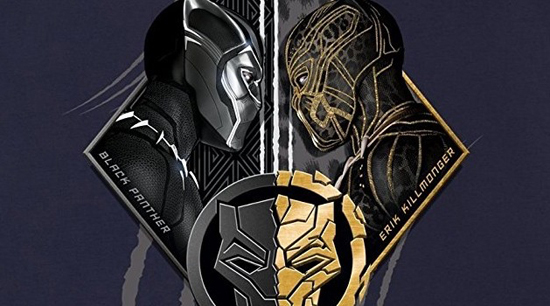
CORALLO: I mean we can also talk about how a billionaire playboy assaulting the mentally ill while sleeping with countless women as a “cover” shouldn’t be a sympathetic character in the first place.
STEVENSON: hahahaha no question Batman is also a fucking psychopath. One with a moral compass though.
HILOBROW: Strangely this gets dealt with best in the (in my minority view, unjustly-maligned) Justice League movie — as when Bruce says of Superman, “he was more human than I am” (I’ve wondered if such scenes were shot after Affleck was re-outed as a molester…)
STEVENSON: Long live Eisenberg.
HILOBROW: And R.I.P. his hair.
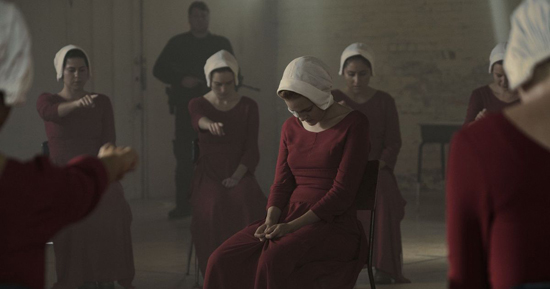
LETO: Not to segue too much from comics but I was just at a Handmaid’s Tale event where Yvonne Strahovski so poignantly pointed out how her character is the villain but she ultimately believes she is doing the right thing. All great villains do.
CORALLO: Absolutely! Which is why they shouldn’t call themselves things like “The Brotherhood of Evil Mutants.”
HILOBROW:

STEVENSON: They can’t think themselves villains. They’re fighting for just as much as the hero. More, for them.
HILOBROW: Handmaid’s Tale is very fair game, @Diana Leto — especially since there was this weirdly lyrical quality to the poetically-written novel… romantic ruins of what we didn’t appreciate the first time, which vaguely ties in with the feminist and inclusive arcadias of Themyscira and Wakanda…
LETO: Handmaid’s Tale definitely speaks of another world but it is not Utopian!
STEVENSON: Not Utopian at all.
HILOBROW: I was talking about what is being missed in The Handmaid’s Tale… and tragically, yeah, the TV version’s Serena Joy thinks she’s restoring some kind of utopia and that this is a worthy cause.
“Shakespearean” is a word that came to my mind a lot while watching the generational strife of the second Jessica Jones series, and of course dynastic strife is all over Black Panther… what is all this blood and guts; are we going medieval or just reopening some wounds of history so they can be treated, as, I think, Papo Colo would say?
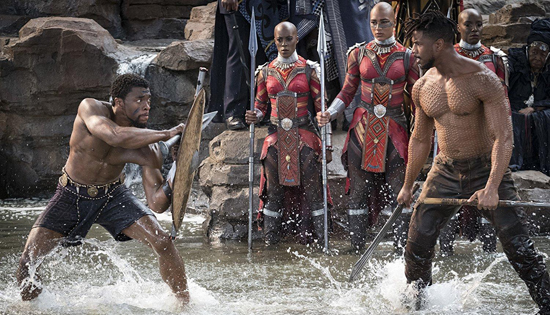
STEVENSON: mmmm it seems all that exists to comment on how far we haven’t come (evolved), how much we haven’t learned from the bloody past and at any moment we’re in deep danger of totally moving back into the dark ages.
HILOBROW: True @Christopher-Rashee Stevenson — it doesn’t take a literal, Shakespearean ghost for our history to haunt us…
CORALLO: I’m only 4 episodes into season 2 of JJ, but I’m glad they’re being less shy with the queer stuff. Like seriously [in season 1] all the straight sex was in bedrooms or fun places and the queer stuff was fully clothed in a law office? Jeez.
STEVENSON: Oh shit!
HILOBROW: Oh, it gets gayer, @Joe Corallo — and this makes me wonder what you thought about the absence of queerness from the Black Panther movie — it seems conspicuous compared to its presence being so central to the Ta-Nehisi Coates comic… unless I’m missing something?
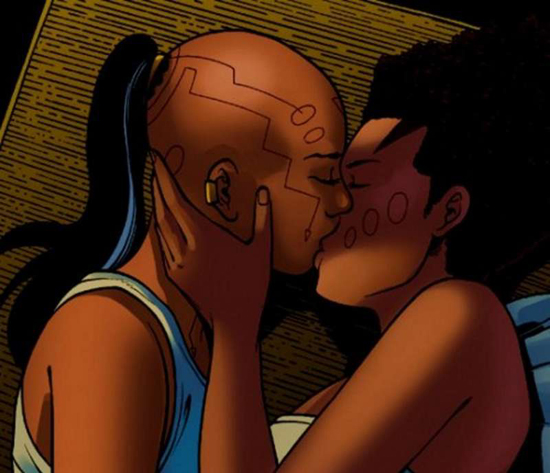
CORALLO: I do think it was kind of messed up. However, I’m not interested in using that as a dividing rod, you know? I think it’s something that should be explored and I certainly hate the excuse of “let’s see how this goes and we can always queer it up later on” which happens A LOT. And they do that stuff often because they think it’ll hurt the international box office. I loved Black Panther, I’ve seen it twice and I’m sure I’ll see it again, but that doesn’t mean even greater things aren’t in store in the future.
LETO: Perhaps I am wrong but I think there was an absence of sex and a spotlight on love/admiration in Black Panther on purpose. When they spoke about how T’Challa would be frozen in Nakia’s presence, it was not because of her beauty or the fact that she is sexy (because, of course she is) but because he loved her for her brains, compassion, drive, and personality.
HILOBROW: Interesting and valid interpretation I had not thought of, @Diana Leto — a royal storyline with an updated form of courtly love…
CORALLO: For sure. And they certainly don’t need to be sexually active in the movie if they keep that up with the future Black Panther movies. Having two women show similar compassion and care for each other would be welcome though.
STEVENSON: I think the whole point was also to not have women only existing in relation to their desire, their affiliation romantically with some dude. I didn’t mind them going light on the sex/romance.
CORALLO: I feel like we also haven’t talked enough about how cool/suave T’Challa was in that movie. Like holy shit. He made James Bond look neurotic. T’Challa is on his death bed at one point, feels bad for like 5 seconds and is like “okay back to work.”
HILOBROW: Lol @Joe Corallo, I think the first thing I said when somebody asked me how the movie was, was that I can now wait indefinitely for Idris to become Bond!
One thing about the Bond flicks — they seem to exist in a kind of perpetual midcentury. We see this elsewhere, like in the eternal 1970s of Proud Mary or most Tarantino or Rodriguez films. And of course Wakanda exists on an alternate timeline right next to the colonial ravages of the world around it (and ours). Does the current era of virtual truth allow us parallel universes to aspire in, and from which we can bring back some more power to the real world than we had before?
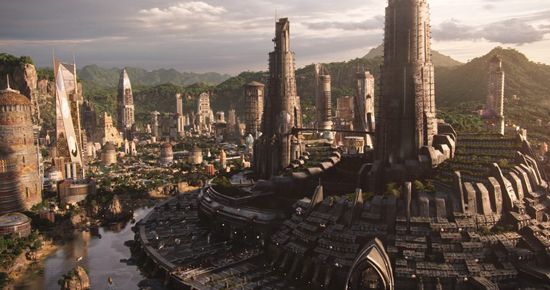
STEVENSON: It does. It also allows a chance for a view into someone else’s “virtual truth.” Allows us to lose our minds if need be with some kind of style and artisanship. We get to create the most ideal of ideals and try to activate that to some level in real life. Which is alternately much better and more boring than virtual life.
LETO: I think we can learn from it. All the parallel universes I’ve had the honor of drawing for or working with, and all the alternate worlds I admire in my favorite shows or movies, allow for a new conversation to start. It creates discussion and ideas, which are always a good thing.
STEVENSON: Ushers in empathy. (For better or worse.)
HILOBROW: Why for worse — just because of the precipices it might send our minds off, or…?
STEVENSON: Absolutely. There’s a danger in being too much of an emotional, intellectual, spiritual sponge I guess. It becomes crucial to monitor what we’re taking in and putting out.
HILOBROW: True — and also a danger of handing over too much — from the white or male side, people can wait for the “approval” of women or people of color, not realizing that this just piles on more burden and lets whites and dudes not have to put it together for themselves — not have to listen, which of course is an interactional process they (we) are not as used to.
LETO: And I think good discussion can happen in utopian and dystopian worlds. When I work with The Jim Henson Company, I always think of the strong female characters in that world… my first love: Miss Piggy. The Muppet world was, or is, sort of my alternative utopia. The characters are dependable and imaginative, the women were always outspoken, but also open and reasonable — if sometimes in an outlandish way. I still strive to be that way.
Whereas, if I watch Jessica Jones or Handmaid’s Tale, I can learn from the females’ anger and determination — it’s relatable and good to reflect. There is something to be said for the way the female protagonists, whether they are the villains or the heroes, have to pick themselves up after a fight, clean their wounds, and stand up again.
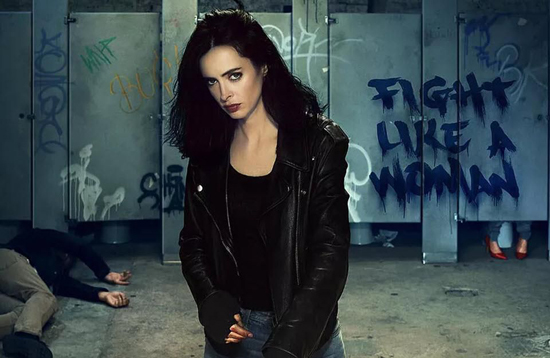
CORALLO: I think we’re entering a point where we can now create cultural and parallel worlds that actually more closely reflect our own experiences, because people are starting to understand that certain views and life experiences are valid when they aren’t their own.
LETO: Agreed, @Joe Corallo. I’m seeing direct parallels in worlds created, to the world we live in. And I am seeing more and more people open to discussing topics they once resisted understanding.
HILOBROW: So true, @Joe Corallo and @Diana Leto — culture-wide (and worldwide) we seem to be realizing that story is a layer of consciousness — that fantasy is an essential component of processing reality, comparing aspiration to possibility, contextualizing what we need in relation to what others seek, etc.
STEVENSON: They say fiction is often the fastest vehicle to truth. They fill our “history” books with their “content.”
HILOBROW: They?
STEVENSON: Stories, myths. Ideas. Risky and dangerous experiments.
HILOBROW: Should’ve realized you were personifying stories. :-)
STEVENSON: haha yes sorry for going off the deep end!
HILOBROW: Not at all, it’s the kind of leap we’re talking about! But yes, history is a legend we write together — and when we unearth new knowledge or even just take a different perspective, a new story can not just open up paths to the future but change the past — like rediscovering powerful female leaders, short-lived nations of escaped slaves, etc. Stories that show us what is possible because it was.
textshow logo designed by Steve Price
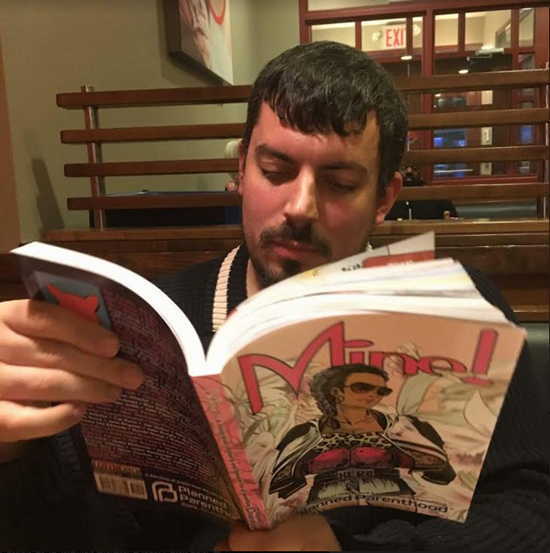
Joe Corallo is a cis queer man, freelance writer and editor, contributor at Geek.com, and organizer and co-editor of Mine! a comics anthology to benefit Planned Parenthood from ComicMix.
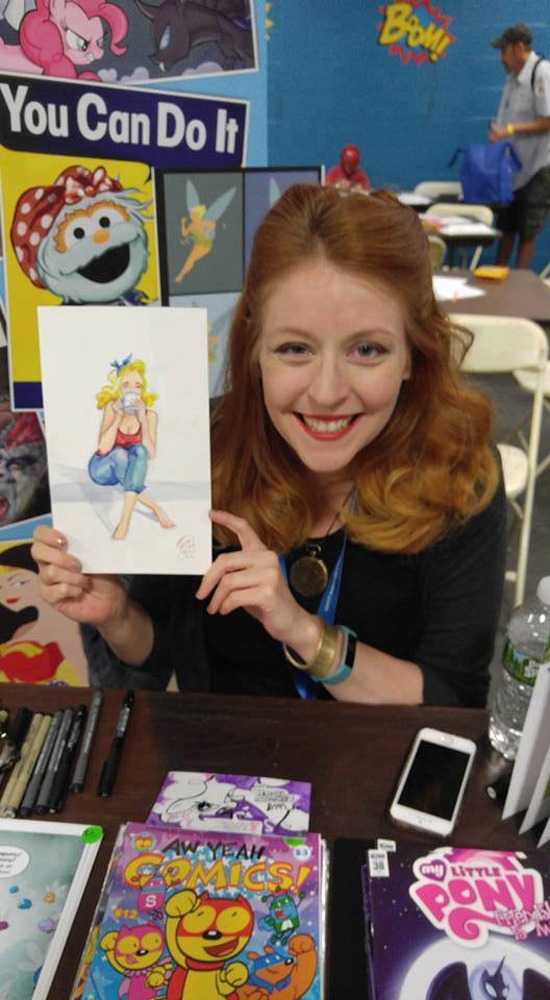
You may recognize Diana Leto‘s name from her exclusive cover artwork for IDW’s My Little Pony and illustration/art-direction for Dark Horse’s Jungle Tales of Tarzan. A professional illustrator and art director for over a decade, she has made a name for herself creating art for clients like Nickelodeon, Jim Henson Legacy, Sesame Street, IDW Comics, and Warner Bros.
Diana earned her “Tarzan Yell” as the illustrator for the comic adaption of Edgar Rice Burroughs’ The Cave Girl and is the colorist for the latest incarnation of Carson of Venus.
Her artwork is featured in Dark Horse’s graphic novel The Halloween Legion, the critically acclaimed and Stan Lee Excelsior Award-nominated all-ages adventure, of which she is co-creator. She is an active participant and presenter at Kids’ Comic Con and Adobe MAX, promoting literacy, education, and by example, gender equality in the professional arts.
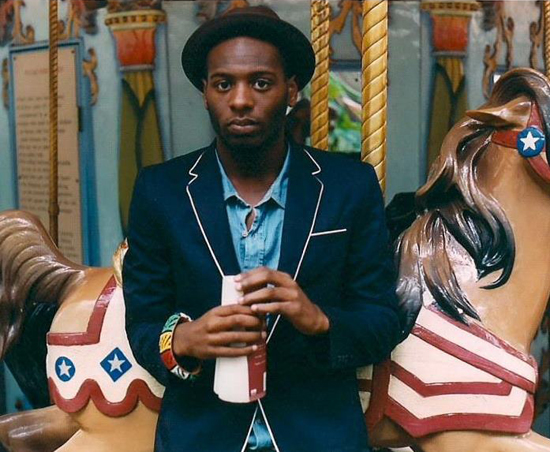
Christopher-Rashee Stevenson is a freelance writer-director originally from Baltimore. His work as both performer and director has been featured between New York and Maryland at venues such as the Eubie Blake Jazz Institute, JACK, Millennium Film Workshop, HERE, Ensemble Studio Theater, The Brick, Bushwick Starr, University Settlement, New Perspectives, The Tank, The Performing Garage, The Actors Studio and The New Vic. Next he can be seen as part of Lincoln Center’s Big Umbrella Festival beginning in April 2018.
MORE COMICS-RELATED SERIES: Douglas Wolk’s LIMERICKANIA | KIRB YOUR ENTHUSIASM — 25 writers on 25 Jack Kirby panels | ANNOTATED GIF — Kerry Callen brings comic book covers to life | COMICALLY VINTAGE — that’s-what-she-said vintage comic panels | DC — THE NEW 52 — an 11-year-old reviews DC’s new lineup | SECRET PANEL — Silver Age comics’ double entendres | SKRULLICISM — they lurk among us | Douglas Wolk’s THAT’S GREAT MARVEL, TAKING LIBERTIES, STERANKOISMS, MARVEL vs. MUSEUM, LIMERICKANIA, WTC WTF
MORE POSTS by ADAM McGOVERN: OFF-TOPIC (2019–2025 monthly) | textshow (2018 quarterly) | PANEL ZERO (comics-related Q&As, 2018 monthly) | THIS: (2016–2017 weekly) | PEOPLE YOU MEET IN HELL, a 5-part series about characters in McGovern’s and Paolo Leandri’s comic Nightworld | Two IDORU JONES comics by McGovern and Paolo Leandri | BOWIEOLOGY: Celebrating 50 years of Bowie | ODD ABSURDUM: How Felix invented the 21st century self | CROM YOUR ENTHUSIASM: C.L. Moore’s JIREL OF JOIRY stories | KERN YOUR ENTHUSIASM: Data 70 | HERC YOUR ENTHUSIASM: “Freedom” | KIRK YOUR ENTHUSIASM: Captain Camelot | KIRB YOUR ENTHUSIASM: Full Fathom Five | A 5-part series on Jack Kirby’s Fourth World mythos | Reviews of Annie Nocenti’s comics Katana, Catwoman, Klarion, and Green Arrow | The curated series FANCHILD | To see all of Adam’s posts, including HiLo Hero items on Lilli Carré, Judy Garland, Wally Wood, and others: CLICK HERE
